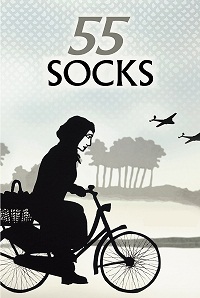| ________________
CM . . .
. Volume XX Number 10. . . .November 8, 2013
excerpt:
1944 is the final year of the Nazi occupation of the Netherlands during World War II. In retaliation for the Dutch support of the Allies, the Nazis have blockaded supplies, and as the cold, wet winter sets in, the necessities of life become increasingly scarce. Shops are empty, and desperate city dwellers head to the countryside to barter their remaining possessions for food. Those with nothing to barter wait in long lines at makeshift soup kitchens. Four women living in a safe house decide to unravel a beautiful knitted bedspread, which, in the course of six days, they knit into 55 socks. The narrator’s mother then sets off on her bicycle to see what can be traded for those socks. Her first few attempts are discouraging – no one wants the socks. But then, she comes across one woman, living in a fine house, warmly dressed and obviously well-fed. This lady “was ready for business”. The 27 pairs of socks are traded for bacon, eggs, wheat, and a scruffy looking chicken. The final sock, almost abandoned, becomes a quart of milk. As the sock trader rides home with her pannier filled with food, the lady with the socks sits down to a project. She loves to knit, and so, she unpicks the socks, and re-knits the yarn into . . . a lovely, lacy bedspread. For the women in the safe house, reprieve finally comes in April of 1945 when the Allies begin dropping food parcels to the Netherlands. This is a short film, barely 9 minutes long, but a powerful little story. The film is black and white, the graphics in the style of wood-cuts, highlighting the bleak reality of experiencing war and all of its deprivations. Voice-overs from war-time newsreels provide an authentic historical context. Despite the desperation of the times, the four women find kinship with each other, purpose in their knitting, and a way to survive and persevere. As for the woman who received the socks – well, she needed something other than food, and the pursuit of her creative passion was important to her survival, too. 55 Socks is a work that can be used in many classroom contexts. English/Language Arts teachers can use it in classes studying literature of World War II, and teachers of World History can use it to show the desperation of daily life in occupied Europe. And during Remembrance Week, 55 Socks is a reminder to students that survival in desperate times can demand creativity, as well as physical bravery. Highly Recommended. Joanne Peters, a retired high school teacher-librarian, lives in Winnipeg, MB.
To comment
on this title or this review, send mail to cm@umanitoba.ca.
Copyright © the Manitoba Library Association. Reproduction for personal
use is permitted only if this copyright notice is maintained. Any
other reproduction is prohibited without permission.
NEXT REVIEW |
TABLE OF CONTENTS FOR THIS ISSUE
- November 8, 2013.
AUTHORS |
TITLES |
MEDIA REVIEWS |
PROFILES |
BACK ISSUES |
SEARCH |
CMARCHIVE |
HOME |
